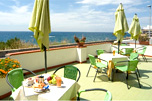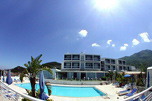Description
Built in the late fifteenth century. During the Aragonese domination in the south, along with a series of strongholds (eg in S. Angelo, Forio, etc..) Connected to each other, with smoke and fire by night, was used as lookout and refuge for the inhabitants of the ancient village of Testaccio. The tower was equipped with tank and furnace in order to resist the hunger caused by the Saracen sieges. It was later used as a dwelling of a local baron. Abandoned for a long time, only in recent years has been restored and reopened.Quadrangular, typical Aragonese construction, without basement, rises from white tuff, on two levels; the eastern side has a portal in the center, enhanced by a thin band of Piperno, and surmounted by a balcony opening from minor decorations triangles, and a passage on the north side wall, supported by the arc rampant, connects the second level of the tower with the surrounding buildings.
This tower was the scene of alegend associated with the frequent Saracen raids on the coast of the island.
During the procession of St. George, the bells of the country, intimidated the people because the pirates had arrived in the waters of Maronti. People gathered near the villages returned to their homes, young villagers climbed to the top of the tower to defend the stoning, women, children and elderly people took refuge in the basement of the same and gathered around the Holy Patron, while the bravest men stationed themselves in the vineyards to spy on the movements of the assailants, who were armed to the teeth had started to climb towards the village. Arrived at gunpoint, the Moors, fled leaving stunned residents of Testaccio. Those lost in the vineyards went to the tower to give security to the inhabitants, who decided to stand guard all night. At the first light of morning a young Saracen was spotted in the square of Testaccio, surrounded by the inhabitants in a few minutes armed with iron bars, shovels and rakes intent on killing him. Fortunately, the priest came that stopped them. Questioned the stranger, who said that they were frightened by men armed with spears, which were carried out everywhere, led by a young horse - "on the face, the lance in rest we pressed relentlessly, in the act of signifying : Back! Back! "Suddenly, the Saracens were terrified and without waiting for any command is launched on the run, trying to reach the ships. The foreigner was among the slowest and failed to reach the classmates. The villagers asked him to recognize the young man instead of a horse. The buck looked around identified it in earthenware representing St. George stuck in the walls of the square. This legend may be given two interpretations:
-Religious-that the escape of the Saracens is a miracle attributed to the patron;-that given by Buonocore who explains the enemies were frightened by a collective hallucination: they exchanged the poles of the screws to spears.
Info
It is situated on the outskirts of town, near a side road that leads to the church of S. Giorgio. George Corofà Civic Museum. It hosts exhibitions and cultural and educational events.
Bus lines: 10 - 11 - 5
Services
![]() Panoramic
Panoramic
![]() Guided tour
Guided tour











